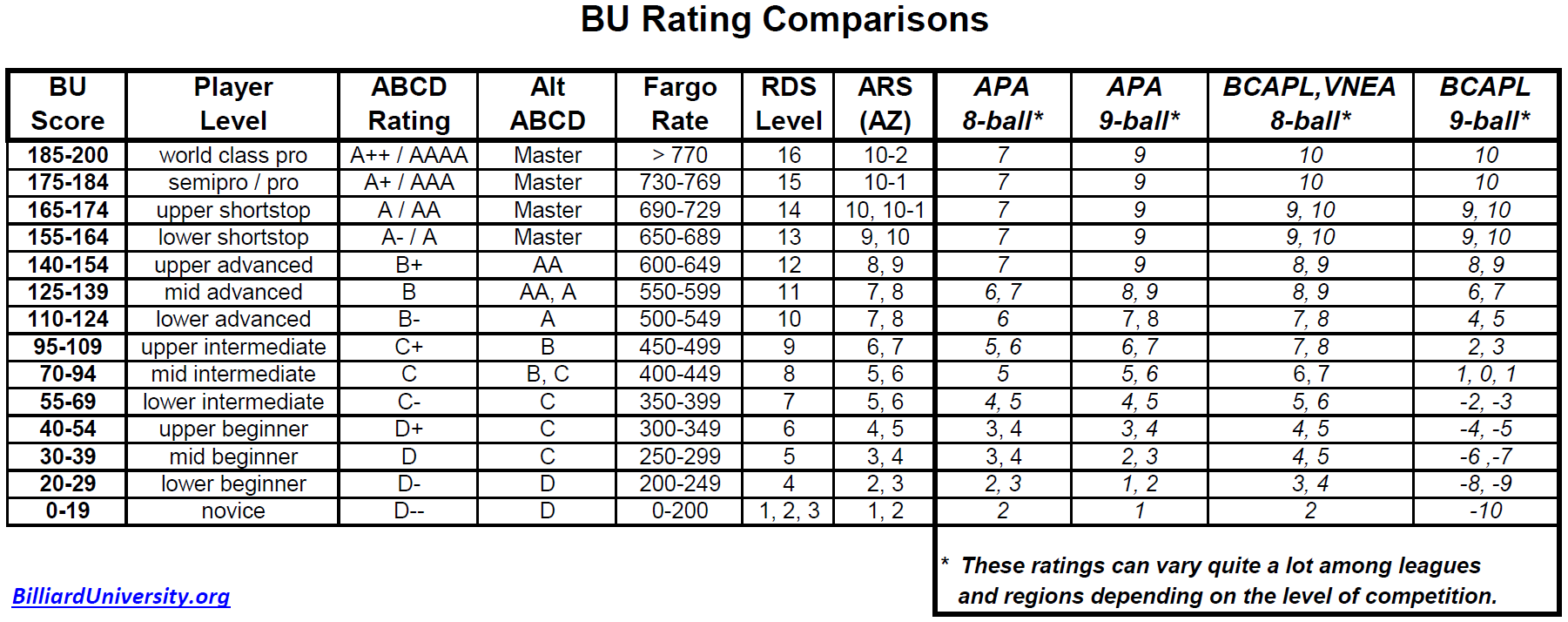Is there a drill that can be used to measure my level of play?
Many “playing the ghost” player rating drills have been developed and used over the years. The phrase “playing the ghost” implies that you are playing by yourself against a fictitious opponent (the “ghost”) who never misses. A ghost drill consists of racking a certain number of balls (e.g., 7, 9, 10, 15), breaking, taking ball in hand after the break, and attempting to run out. Alternatively, you can just randomly spread the balls on the table before taking ball in hand. If you run out, you have beaten the “ghost.” You can keep score by keeping track of your rack winning percentage or by totaling the total number of balls pocketed before missing in a given number of racks (e.g., 10). You can also play “progressive ghost,” where you increase the number of balls on the table when you succeed running a certain number of racks (e.g., 2 or 3 of 3) and decrease the number of balls when you fail to run the majority of racks (e.g, 0 or 1 of 3). The number of balls you end up at after a long session is your score.
“Playing the ghost” rating drills are useful to assess your level of play and track improvement over time. They also provide practice with offensive skills (shot making, position play, handling of clusters and problem balls, and breaking). Safety play, a very important part of the game, is not addressed in “playing the ghost” drills. Example “playing the ghost” drills and rating systems are the 9-ball rating drill or Sharivari extended ghost drill (which provide a 1-10 and A-D rating) and the 10-ball version. The 15-ball-rotation rating drill provides a similar way to rate performance. The 10-ball-ghost version is the most recommended and seems to provide fairly accurate player ratings. Here’s a record-keeping spreadsheet created by “tashworth19191” (in AZB post) useful for tracking progress over time with the 9-ball rating drill.
The “playing the ghost” drills do not test a complete range of pool skills, but they do a decent job at rating a person’s primary offensive skills. However, the scores can vary a lot from one session to the next, and there can be a fair amount of luck (both good and bad) involved concerning ball clustering and weird run-out patterns; but if you do a bunch of sessions and throw out the low and high scores, the median (middle) score provides a fairly accurate measure of one’s offensive ability.
Here’s an impressive example of a pro (Darren Appleton) “playing the ghost” effectively.
A variation of “playing the ghost” that incorporates defensive play allows safeties. If you hide the CB from the OB, you get ball in hand and can continue your run. The assumption is that the “ghost” can’t jump or kick.
A better system for determining and monitoring a player’s level of ability is the FargoRate rating and handicapping system. If you don’t have a FargoRating, you can approximate your rating with playing-ability tests like the Runout Drill System (RDS) or the Billiard University (BU) Playing Ability Exams. They assess a wide range of important pool skills in a methodical, thorough, and consistent way. They also provide a numeric and descriptive rating. The BU rating comparison chart shows how the BU rating correlates to other commonly used rating and handicapping systems, including the ABCD rating system:

For more information, see “Player Ratings” (BD, December, 2020).
As with all rating systems and drills, results can vary with table size. Generally, the rating systems are developed assuming the drills are done on a typical-difficulty-level, standard 9′ table. The Table Difficulty Factor (TDF) offers a way to compare difficulty levels of different tables to help put scores and ratings into proper perspective.
More rating drills can be found on the drills and exercises resource page.
Dr. Dave keeps this site commercial free, with no ads. If you appreciate the free resources, please consider making a one-time or monthly donation to show your support:
